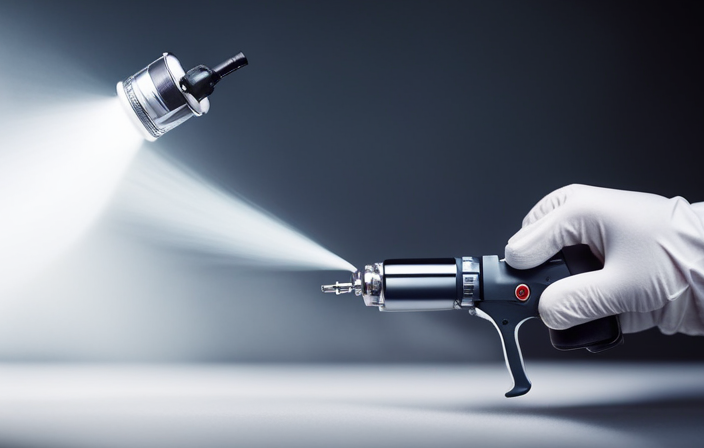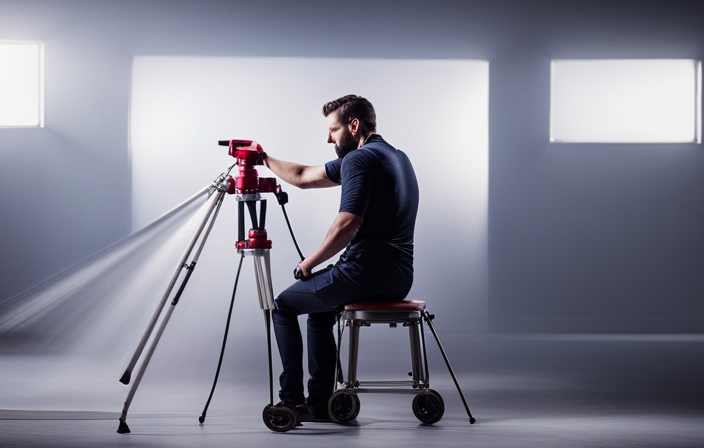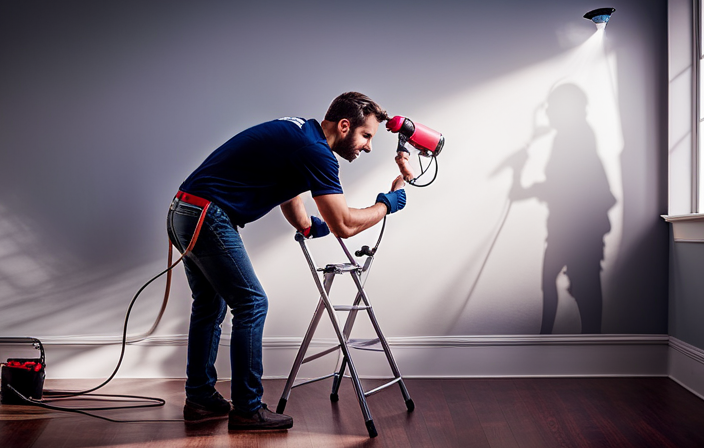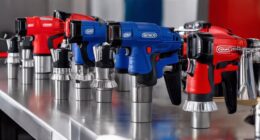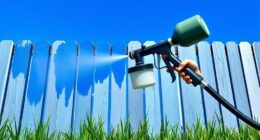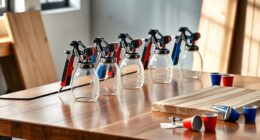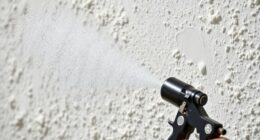If you are getting ready to take on a painting project and thinking about using an airless paint sprayer for a smooth and efficient application, you have come to the right spot. I am here to give you all the essential tips and methods for effectively applying Kilz with an airless paint sprayer.
In this article, I’ll walk you through the necessary materials you’ll need, how to prepare the surface properly, and even how to dilute and load the Kilz paint for optimal results.
We’ll also cover adjusting the sprayer settings, starting the spraying process, and evaluating the coverage to ensure a smooth and even finish.
Once we’re done painting, I’ll show you how to remove the masking tape and drop cloths, as well as how to clean and store your tools properly.
So get ready to transform your walls with Kilz and an airless paint sprayer, and enjoy the satisfaction of a job well done!
Key Takeaways
- Proper safety equipment and surface preparation are essential for a successful Kilz paint spraying project.
- Diluting the paint and loading it into the sprayer correctly are crucial for achieving a smooth and even application.
- Adjusting the sprayer settings, testing the spray pattern, and choosing the appropriate nozzle size are important for optimal performance.
- Mastering spray techniques, such as maintaining a consistent distance, applying thin coats, and overlapping each pass, will result in a professional finish.
Gather the Necessary Materials
Now that you’ve got your airless paint sprayer ready to go, it’s time to gather all the materials you’ll need for the job.
First, make sure you have the necessary safety equipment, such as goggles, a respirator, and gloves, to protect yourself while using the sprayer.
Additionally, gather the paint you’ll be using, as well as any primer or sealer if needed.
Don’t forget to have enough drop cloths or plastic sheeting to cover the surrounding area and protect it from overspray.
It’s also a good idea to have a few extra sprayer tips on hand in case one gets clogged or damaged during the job.
Now that you have all your materials ready, we can move on to preparing the surface for painting.
Prepare the Surface
Before you begin, have you properly prepped the surface? Surface preparation techniques are crucial for achieving a flawless finish when using an airless paint sprayer with Kilz.
Start by cleaning the surface thoroughly to remove any dirt, dust, or grease. Sanding is also important to ensure a smooth and even surface. Fill any cracks or holes with a suitable filler and allow it to dry completely before proceeding.
Additionally, it’s recommended to use a primer before applying Kilz with an airless paint sprayer. This will help the paint adhere better and provide a more durable finish. Remember to follow the manufacturer’s instructions for the specific primer and Kilz product you’re using.
With a properly prepared surface, you can now move on to diluting and loading the Kilz paint.
Dilute and Load the Kilz Paint
Before starting to spray Kilz paint with an airless paint sprayer, it’s important to read the instructions carefully. If necessary, dilute the paint according to the manufacturer’s recommendations.
Once the paint is ready, load it into the sprayer and make sure to stir it thoroughly to ensure an even consistency. Lastly, it’s advisable to use a paint strainer to prevent any debris or clumps from clogging the sprayer nozzle.
Read the instructions
First things first, make sure you give those instructions a good read before diving into spraying Kilz with your airless paint sprayer. Following the instructions is crucial when using an airless paint sprayer to ensure safety and avoid potential risks.
Here are three common mistakes people make when using an airless paint sprayer and how to avoid them:
-
Neglecting to wear proper protective gear can result in health hazards. Always wear goggles, a mask, and gloves to protect yourself from paint fumes and potential overspray.
-
Failing to prepare the surface properly can lead to poor paint adhesion and a subpar finish. Clean the surface thoroughly and remove any loose paint or debris before spraying Kilz.
-
Overlooking the recommended pressure settings can cause uneven coverage or paint splattering. Adjust the pressure according to the manufacturer’s instructions for optimal results.
Now that you understand the importance of following instructions, let’s move on to the next step: diluting the paint if necessary.
Dilute the paint if necessary
Now, let’s dive into the next crucial step: if needed, you’ll want to dilute your paint to achieve the perfect consistency for smooth and even application. Diluting the paint is important because it ensures that the paint flows smoothly through the airless paint sprayer without clogging or splattering.
The dilution ratio will depend on the type of paint you’re using, so be sure to check the instructions or the paint can for the recommended ratio. Typically, you’ll mix water or a paint thinner with the paint until you reach the desired consistency. This will help you achieve better coverage and avoid streaks or unevenness on the surface.
Once you’ve achieved the right paint consistency, you can now move on to the next step of loading the paint into the sprayer, ensuring a seamless painting process.
Load the paint into the sprayer
To ensure a seamless painting process, it’s essential to fill the sprayer with the prepared paint mixture. Start by checking the manufacturer’s instructions for your specific paint sprayer techniques. Some sprayers may require you to remove the paint container and fill it separately, while others allow you to load the paint directly into the sprayer.
Make sure to pour the paint slowly and avoid overfilling, as this can cause clogs or uneven spraying. If you encounter any issues, such as paint not flowing properly or inconsistent spray patterns, refer to the troubleshooting section in the sprayer’s manual.
Once the paint is loaded, it’s time to stir the paint thoroughly to ensure an even consistency throughout. This will help achieve a professional-looking finish.
Stir the paint thoroughly
Ensure a smooth and even paint application by thoroughly stirring the mixture, achieving a consistent color and texture. Proper stirring techniques are essential to prevent clumps and ensure that the paint is evenly mixed.
Start by using a stirring stick or a paint mixer attachment for your drill. Insert the stick or attachment into the paint container and mix in a circular motion, making sure to scrape the sides and bottom to incorporate any settled pigment. Continue stirring until the paint is smooth and free of lumps.
Common mistakes include not stirring enough or stirring too vigorously, which can introduce air bubbles into the paint. These bubbles can create an uneven finish on the surface.
Once the paint is well mixed, transition into the subsequent section about using a paint strainer to ensure a flawless application.
Use a paint strainer
Don’t forget to strain your paint using a paint strainer, like a sieve for your creativity, to remove any impurities and ensure a smooth and flawless application. Using a paint strainer offers several benefits. Firstly, it helps to eliminate any lumps, debris, or dried paint particles that may have formed during storage. This ensures that your paint flows smoothly through the sprayer, preventing clogs and ensuring an even distribution of color. Secondly, a paint strainer helps to remove any foreign particles that could mar the finish of your project, such as dirt or dust. When choosing a paint strainer, consider the type of paint you will be using and the desired finish. Mesh strainers are ideal for latex paints, while paper strainers are better suited for oil-based paints. Once you have strained your paint, it’s time to adjust the sprayer settings for optimal performance.
Adjust the Sprayer Settings
To adjust the sprayer settings, I first set the pressure to the recommended level for the Kilz paint. This ensures that the paint will atomize properly and provide a smooth finish.
Next, I choose the spray pattern that best suits the surface I’m painting. Whether it’s a wide fan pattern for large areas or a narrow round pattern for detailed work, selecting the right pattern is crucial for achieving the desired results.
Finally, before starting the actual painting, I always test the spray on a scrap surface to make sure the settings are correct and the paint is spraying evenly. This allows me to make any necessary adjustments before applying the paint to the actual project.
Set the pressure
Adjust the pressure on your airless paint sprayer until it feels just right, allowing you to effortlessly coat your surfaces with Kilz. Adjusting the pressure is crucial for achieving optimal paint application and troubleshooting any issues you may encounter.
If the pressure is too high, the paint may atomize too much, leading to overspray and a thin coat. On the other hand, if the pressure is too low, the paint may not atomize properly, resulting in a heavy and uneven application.
Start by setting the pressure at the manufacturer’s recommended level, and then adjust it gradually as needed. Test the spray pattern on a scrap surface and make small adjustments until you achieve a consistent and even coat.
With the pressure set correctly, it’s time to move on to choosing the spray pattern for your Kilz application.
Choose the spray pattern
After setting the pressure on the airless paint sprayer, it’s time to choose the spray pattern that will achieve the desired results. There are various spray pattern techniques to consider, such as horizontal, vertical, round, and wide fan patterns.
Each pattern offers a different coverage and finish, so it’s important to choose the one that suits your project best. To achieve the desired pattern, you need to select the right nozzle size. Smaller nozzles create a narrower pattern, while larger ones provide a wider coverage.
Take into account the surface you’re spraying and the type of paint you’re using to make the right choice. Once you’ve chosen the spray pattern and nozzle, it’s time to test the spray on a scrap surface to ensure it’s delivering the desired coverage and finish.
Test the spray on a scrap surface
First, make sure you have a scrap surface ready to test the spray – can you afford to skip this step and risk ruining your project? Testing the spray on a scrap surface is an essential technique when using an airless paint sprayer with Kilz. It allows you to adjust the spray pattern and ensure the paint is flowing smoothly before starting your actual project.
Choose a scrap surface that is similar to the one you will be painting, such as a piece of cardboard or an old board. Hold the sprayer at a distance of 12-18 inches and apply the paint in a consistent, even motion. Pay attention to the coverage and any potential clogs or drips.
Once you are satisfied with the test spray, you can confidently move on to start spraying your project.
Start Spraying
When starting to spray with an airless paint sprayer, it’s important to hold the sprayer correctly to ensure control and accuracy.
Maintaining a consistent distance from the surface being sprayed helps to achieve an even coat and avoid drips or blobs.
Applying thin coats allows for better adhesion and reduces the risk of runs, while overlapping each pass ensures full coverage.
It’s also important to take breaks to avoid over-spraying and allow the paint to dry properly.
Hold the sprayer correctly
Ensure you’re gripping the airless paint sprayer properly to achieve flawless results and unleash your inner painting maestro. Here are three key tips to ensure a proper grip and wrist alignment:
- Hold the sprayer with a firm grip, but not too tight, allowing for control and maneuverability.
- Keep your wrist in a straight and neutral position to prevent strain and fatigue.
- Position your hand towards the middle of the sprayer for better balance and stability.
By following these guidelines, you’ll have better control over the sprayer and avoid any unnecessary accidents.
Now that you have the proper grip, let’s move on to the next section about maintaining a consistent distance for a professional finish.
Maintain a consistent distance
Now that you’ve got a good grip on the sprayer, let’s talk about how to maintain a consistent distance for a pro-level finish. To achieve a flawless result, it’s crucial to maintain proper technique and avoid overspraying. By keeping a consistent distance from the surface you’re painting, you’ll ensure an even application and minimize the risk of drips or runs.
To help you visualize the ideal distance, refer to the table below:
| Distance from Surface | Result |
|---|---|
| 12 inches | Light coat |
| 10 inches | Medium coat |
| 8 inches | Heavy coat |
Remember to adjust the distance based on the specific requirements of your project. By maintaining a consistent distance, you’ll achieve a smooth and professional-looking finish. Now, let’s move on to the next section and learn how to apply thin and even coats without wasting any time.
Apply thin and even coats
To achieve a professional-level finish, it’s important to apply thin and even coats. This can be visually represented by the ideal distances mentioned earlier – 12 inches for a light coat, 10 inches for a medium coat, and 8 inches for a heavy coat. Applying multiple coats ensures complete coverage and helps achieve professional results. Here are some tips to apply thin and even coats:
- Start by spraying in a horizontal motion, moving from left to right.
- Keep the sprayer moving at a consistent speed to avoid pooling or dripping.
- Overlap each pass by about 50% to ensure even coverage.
- Maintain a steady hand and avoid excessive pressure on the sprayer trigger.
By following these guidelines, you can achieve a smooth and flawless finish.
Now, let’s move on to the next step: overlapping each pass for seamless results.
Overlap each pass
To achieve a seamless and polished result, it’s recommended that you carefully overlap each stroke as you apply the coats. This technique ensures achieving even coverage and avoids streaks on your surface.
When using an airless paint sprayer, it’s important to maintain a consistent speed and distance from the surface. As you move the sprayer back and forth, make sure to slightly overlap each pass with the previous one. This overlapping technique ensures that the paint is evenly distributed and eliminates any gaps or uneven spots. By consistently overlapping, you’ll achieve a smooth and professional finish.
Now, let’s move on to the next section about taking breaks to avoid over-spraying and ensure the best results.
Take breaks to avoid over-spraying
Taking breaks throughout the painting process is crucial in order to prevent excessive spraying and achieve the best possible results. Here are four reasons why taking breaks is important when using an airless paint sprayer:
-
Avoid over-spraying: Pausing periodically allows you to assess the coverage and make adjustments if needed, preventing over-spraying and wasting paint.
-
Prevent drips and runs: Giving the paint time to settle and dry between coats reduces the chances of drips and runs, ensuring a smooth and even finish.
-
Reduce fatigue: Taking short breaks helps prevent muscle fatigue and allows you to maintain a steady hand, resulting in more precise and controlled spraying.
-
Maintain equipment performance: Resting the sprayer periodically prevents overheating and prolongs the lifespan of the equipment, ensuring consistent performance throughout the project.
By taking breaks, you can achieve better control, prevent over-spraying, and ultimately achieve a professional-looking paint job.
Now, let’s move on to the next step, cleaning the sprayer.
Clean the Sprayer
To clean the sprayer, the first step is to empty the paint reservoir completely.
Next, I flush the sprayer with water or solvent to remove any remaining paint residue.
Then, I disassemble and clean the nozzle thoroughly using a brush or cloth.
Finally, I make sure to dry the sprayer completely and store it properly to prevent any damage or clogging.
Empty the paint reservoir
Once the paint reservoir is emptied, a whole new world of painting possibilities will open up before you.
To refill the paint reservoir, follow these steps:
- Ensure that the sprayer is turned off and unplugged.
- Then, remove the paint container from the sprayer and carefully pour any leftover paint back into the original paint can or a suitable container.
- Next, clean the container thoroughly with a rag or paper towel to remove any remaining paint residue.
- Once the container is clean, refill it with the desired paint color or type.
- If you encounter any issues during this process, such as clogging or leaking, refer to the troubleshooting guide provided by the manufacturer.
With the paint reservoir refilled, we can now move on to the next step: flushing the sprayer with water or solvent.
Flush the sprayer with water or solvent
As you unplug the sprayer, a rush of anticipation fills the air, knowing that the next step is to flush the paint-splattered tool with water or solvent. Proper sprayer maintenance is crucial for optimal performance and longevity.
Flushing the sprayer not only removes any remaining paint residue but also helps prevent clogs and ensures smooth operation. To flush the sprayer, fill the paint reservoir with water or solvent, then attach the spray gun and hose. Start by spraying the solution onto a waste surface until the liquid runs clear. Pay close attention to the nozzle and ensure that any debris is thoroughly flushed out. This step is essential for troubleshooting and avoiding any potential issues.
Transitioning into the subsequent section about disassembling and cleaning the nozzle, it is important to keep the sprayer clean and free of any remaining paint particles.
Disassemble and clean the nozzle
Get ready to dive into the next step of maintaining your sprayer – it’s time to disassemble and give that nozzle a thorough cleaning! Cleaning techniques for the nozzle may vary depending on the type of sprayer you have, so refer to the manufacturer’s instructions for specific guidance.
Generally, you’ll need to remove the nozzle from the sprayer and soak it in a cleaning solution or use a small brush to scrub away any paint residue. Pay close attention to any clogs or buildup and use troubleshooting tips, such as using a wire or toothpick to gently remove any obstructions.
Once the nozzle is clean, rinse it with water and reassemble it back onto the sprayer. With the nozzle sparkling clean, it’s time to move on to the next section about how to dry and store the sprayer properly.
Dry and store the sprayer properly
To ensure the longevity of your sprayer, it’s essential to properly dry and store it after each use so that it’s ready for your next project. Follow these steps for proper maintenance and to prevent clogs:
-
Disconnect the sprayer from the power source and remove the spray tip and guard.
-
Use a clean cloth or paper towel to wipe off any excess paint from the sprayer.
-
Run clean water through the sprayer until it runs clear to remove any remaining paint residue.
-
Allow all the components to air dry completely before reassembling and storing the sprayer.
By properly drying and storing your sprayer, you can prevent paint build-up and ensure its optimal performance.
Once you’ve completed these steps, you can now move on to the next section and evaluate the coverage of the Kilz paint using your airless paint sprayer.
Evaluate the Coverage
Assess the extent of coverage by spraying Kilz with an airless paint sprayer. This step is crucial to ensure that all desired surfaces are adequately coated.
To evaluate the durability of the coverage, examine if the Kilz has evenly adhered to the surface without any thin or bare spots. Analyze the drying time of the Kilz to determine if it has fully dried and cured. Keep in mind that the drying time may vary depending on factors such as humidity and temperature.
Once you’re satisfied with the coverage and drying time, it’s time to move on to the next step.
Remove the masking tape and drop cloths, revealing the freshly painted surface and preparing it for the next stage of the painting process.
Remove the Masking Tape and Drop Cloths
When removing the masking tape, I make sure to do it carefully to avoid any damage to the freshly painted surface.
After removing the tape, I fold up the drop cloths and dispose of them properly to prevent any paint from spreading.
Lastly, I thoroughly clean up any paint spills or drips to leave the area looking neat and tidy.
Carefully remove the tape
Gently peel off the tape, revealing clean edges and a precise paint job. Removing the tape properly is crucial to avoid any paint seepage and maintain the professional finish you desire. Here’s how to do it right:
- Start at a corner and pull the tape back slowly, making sure to keep it at a 45-degree angle to prevent any tearing or damage to the painted surface.
- If you encounter any resistance, use a utility knife to score along the edge of the tape before pulling it off.
- Check for any areas where the paint has bled through. If you find any, use a small brush to touch up those spots before moving on.
Now that the tape is removed, it’s time to fold and dispose of the drop cloths, ensuring a clean and efficient cleanup process.
Fold and dispose of the drop cloths
To efficiently clean up your work area, start by folding and disposing of the drop cloths. But have you considered how this step can save you time and effort in the long run?
When folding the drop cloths, use a technique that allows you to contain any paint residue and prevent it from spreading. Begin by folding the cloth in half, ensuring that any paint-covered areas are facing inward. Then, fold it in half again, repeating until you have a compact square. This folding technique not only makes disposal easier but also minimizes the chances of paint spills or drips.
Once the drop cloths are folded, carefully place them in a garbage bag or designated disposal container.
Now, let’s move on to the next section about cleaning up any paint spills or drips.
Clean up any paint spills or drips
Now it’s time for you to tackle any paint spills or drips that may have occurred during your project. Cleaning up these spills is essential to achieve a professional finish.
Here are some effective cleaning techniques to help you get rid of paint spills:
- Blot the spill immediately with a clean cloth or paper towel to absorb as much paint as possible.
- Use a mild detergent mixed with warm water to gently scrub the affected area.
- For stubborn spills, you can try using a paint thinner or solvent, but be cautious and follow the manufacturer’s instructions.
Preventing paint spills is also important. Make sure to secure the paint can lid tightly and avoid overfilling your paint tray or container. Additionally, take your time and be mindful of your movements while spraying to minimize the chances of drips and spills.
Once you’ve cleaned up any paint spills, you can move on to the next step of cleaning and storing the tools.
Clean and Store the Tools
When it comes to clean up after using an airless paint sprayer, there are a few key points to remember.
First, make sure to thoroughly clean the paint tray and stirrer to remove any leftover paint.
Next, dispose of or clean the paint strainer to ensure it’s ready for future use.
Finally, wash and dry the brushes properly and store the sprayer and other tools in a safe and organized manner.
By following these steps, you can ensure that your tools are ready to go for your next project.
Clean the paint tray and stirrer
First, grab a rag and give the paint tray and stirrer a thorough wipe-down, removing any lingering residue like a magician making a stubborn stain disappear. Cleaning tools and maintaining equipment is crucial to ensure the best performance of your airless paint sprayer. To make the cleaning process easier, you can use a 3 column and 5 row table to organize the steps:
| Step | Actions |
|---|---|
| 1. | Remove excess paint from the tray and stirrer. |
| 2. | Rinse the tray and stirrer with warm water. |
| 3. | Use a mild detergent to wash away any remaining paint. |
| 4. | Scrub the tray and stirrer gently with a sponge or brush. |
| 5. | Rinse thoroughly and dry with a clean cloth. |
Once the paint tray and stirrer are clean, you can move on to the next step – disposing of or cleaning the paint strainer.
Dispose of or clean the paint strainer
To properly dispose of or clean the paint strainer, you’ll want to follow these simple steps:
- Remove the paint strainer from the sprayer and examine it for any large clumps of paint.
- If the strainer is clogged with paint, carefully scrape off the excess using a putty knife or old brush.
Dispose of the paint strainer in accordance with your local regulations for hazardous waste.
- If the strainer is still in good condition and can be reused, rinse it thoroughly with warm water until all the paint residue is removed.
Now that you’ve taken care of the paint strainer, it’s time to move on to the next step: washing and drying the brushes.
Wash and dry the brushes
After properly disposing of or cleaning the paint strainer, it’s time to wash and dry the brushes. Proper brush cleaning techniques are essential for maintaining the quality and lifespan of your brushes.
Start by rinsing the brushes in warm water to remove any excess paint. Use a mild soap or brush cleaner to gently scrub the bristles, making sure to remove all paint residue. Pay special attention to the base of the bristles where paint can accumulate.
Rinse the brushes thoroughly to ensure all soap is removed. Next, gently pat the brushes dry with a clean cloth or paper towel. Avoid using excessive force, as this can damage the bristles.
Finally, allow the brushes to air dry completely before storing them. Proper brush maintenance is crucial for achieving a smooth and even spray with your airless paint sprayer. With the brushes clean and dry, we can now move on to properly storing the sprayer and other tools.
Properly store the sprayer and other tools
After washing and drying the brushes, it is essential to properly store the sprayer and other tools to ensure their longevity and prevent any damage. To properly maintain the airless paint sprayer, follow these steps:
-
Clean the sprayer thoroughly: Remove any leftover paint by flushing the system with water or a cleaning solution recommended by the manufacturer.
-
Disassemble and clean the nozzle: Remove the nozzle and soak it in a cleaning solution to remove any dried paint or debris that could cause clogs.
-
Lubricate moving parts: Apply a small amount of lubricant to the sprayer’s moving parts to keep them running smoothly.
By following these steps, you can prevent clogs in the sprayer nozzle and ensure it remains in good working condition for future use. Now, with your tools properly stored, you can move on to the next section and enjoy your newly painted walls!
Enjoy Your Newly Painted Walls!
I can’t help but admire the smooth finish on my newly painted walls.
It’s amazing how a fresh coat of paint can transform a room.
I appreciate the time and effort I saved by using an airless paint sprayer, making the process quick and efficient.
Now, I can’t wait to share my success with others and show off my beautifully painted walls.
Admire the smooth finish
Take a moment to appreciate the flawlessly sleek finish that’ll leave you in awe. Achieving a smooth finish has numerous benefits, including professional-looking results that can elevate the overall aesthetic of your space.
Here are four key reasons why a smooth finish is worth the effort:
-
Enhanced Durability: A smooth finish ensures better adhesion, making your walls more resistant to chipping, peeling, or cracking.
-
Timeless Appeal: The smooth texture adds a touch of elegance and sophistication, creating a timeless look that never goes out of style.
-
Easy to Clean: Smooth surfaces are easier to wipe down and maintain, making it simple to keep your walls looking fresh and new.
-
Professional Finish: With an airless paint sprayer and Kilz, you can achieve an even, professional-quality finish that rivals the work of a seasoned painter.
Now that you’ve admired the smooth finish, you’ll appreciate the time and effort saved when it comes to the next steps.
Appreciate the time and effort saved
Imagine the hours of backbreaking work you’ll save by simply appreciating the time and effort saved with a smooth finish! Using an airless paint sprayer like Kilz can significantly reduce your painting time. The high-pressure system allows for quick and even coverage, eliminating the need for multiple coats.
With this time-saving technique, you can tackle larger projects in a fraction of the time it would take with traditional methods. Not only does it save you time, but it also ensures a professional-looking finish. The airless sprayer evenly distributes the paint, resulting in a smooth and flawless surface. No more brush marks or roller streaks to worry about!
So, when you’re finished, step back and admire the time and effort you’ve saved, knowing that your project is completed with precision and efficiency. Now, you can move on to the next step and share your success with others.
Share your success with others
Share your success with others by showcasing the flawless finish achieved with this efficient time-saving technique.
Sharing experiences and learning from others is an important part of any DIY project. By sharing your success, you not only inspire and motivate others to try the same technique but also create a community of like-minded individuals who can exchange tips and tricks.
Whether it’s through social media platforms, online forums, or local meetups, there are numerous ways to share your achievements. By doing so, you not only contribute to the DIY community but also have the opportunity to learn from others and improve your own skills.
So don’t hesitate to share your experience and help others achieve the same level of success with spraying Kilz using an airless paint sprayer.
Frequently Asked Questions
Can I use Kilz paint with a brush or roller instead of an airless paint sprayer?
Using a brush or roller with Kilz paint is a viable alternative to an airless sprayer. Pros of using an airless sprayer include faster application and smoother finish, but using a brush or roller allows for more control and precision.
How long does it take for Kilz paint to dry after it has been sprayed on?
Kilz paint typically takes about 1-2 hours to dry. To speed up drying time, ensure proper ventilation, use a dehumidifier, or use fans to circulate air. Avoid applying thick coats as they may take longer to dry.
Can I use Kilz paint on outdoor surfaces, such as fences or decks?
Sure, you can use Kilz paint on outdoor surfaces like fences or decks. It’s one of the best outdoor paints for these projects. Before painting, make sure to clean and prep the surfaces properly for better adhesion and durability.
How many coats of Kilz paint should I apply for optimal coverage?
For optimal coverage with Kilz paint, it is recommended to apply two coats. Allow the first coat to dry completely before applying the second coat. Wait at least 1 hour between coats for best results.
Can I use Kilz paint on surfaces that have already been painted with a different brand of paint?
Yes, Kilz paint can be used as a primer for a different brand of paint. It is also suitable for use on unpainted surfaces. Kilz provides excellent adhesion and helps create a smooth, long-lasting finish.
Conclusion
After following these steps, I must say that spraying Kilz with an airless paint sprayer was a breeze! The paint went on smoothly and evenly, covering the surface flawlessly.
It was like watching a gentle rain shower, transforming dull walls into a vibrant masterpiece. The process was straightforward, and with the right tools and preparation, anyone can achieve professional-looking results.
So go ahead, grab your sprayer and unleash your creativity. It’s time to enjoy the beauty of your newly painted walls!
